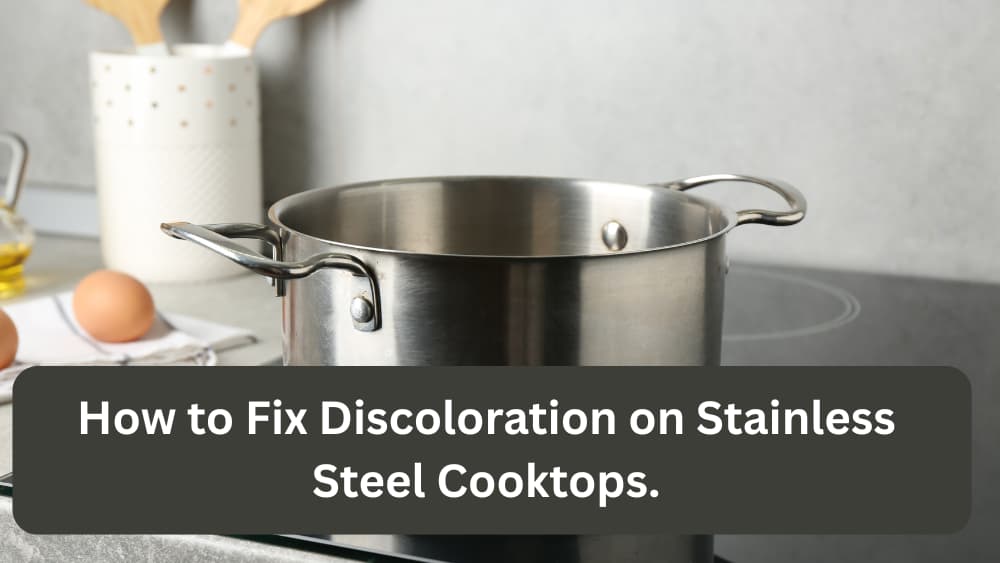Stainless steel looks sleek—until it doesn’t. One heavy sear session, a few boil-overs, or a month of “I’ll wipe it later,” and the cooktop starts flashing rainbow tints, yellow rings, brown halos, or cloudy film. Scrubbing harder usually makes it worse: micro-scratches catch the light, fingerprints stick, and the sheen dulls.
Here’s the good news: most stainless discoloration isn’t permanent. With the right methods—matched to the type of discoloration—you can restore the finish, protect the metal’s natural chromium-oxide layer, and keep that reflective, uniform look.
This guide walks you through diagnosing the stain, fixing the finish step by step, and preventing future discoloration—without scratching or stripping the steel.
Key Takeaways
- Identify the discoloration type first (heat tint, oil/grease film, hard-water mineral haze, sugar/sauce burns, chemical etch).
- Clean in this order: cool surface → degrease → demineralize → de-tint (if needed) → passivate/protect.
- Use non-abrasive tools: microfiber, soft sponge, nylon brush; avoid steel wool and harsh powders.
- Wipe with the grain—never across it—to prevent visible swirl marks.
- Prevent new discoloration with immediate wipe-downs, pan management, and periodic passivation.
What Causes Discoloration on Stainless Cooktops?
Stainless steel resists rust because chromium in the alloy forms a thin, invisible chromium-oxide film (the “passive layer”). Discoloration is typically one of these:
- Heat tint / rainbowing (blue, gold, purple): high heat thickens/oxidizes the surface layer, creating interference colors.
- Oil/grease polymerization (brown/amber film): cooking oils bake into a varnish-like residue.
- Hard-water haze (milky, cloudy): calcium/magnesium deposits from steam/boil-overs.
- Sugar and sauce burns (dark rings, sticky spots): caramelized sugars carbonize on hot steel.
- Chemical etch (dull patchy area): bleach, oven cleaner, or chloride-heavy chemicals attack the passive layer.
Each needs a tailored fix. One cleaner for all problems usually fails—or scratches.
How Do You Safely Prep Before Any Fix?
- Cool completely. Heat + cleaner = streaks, flash-drying, and possible damage.
- Dry dust first. Lift grit with a dry microfiber to avoid dragging particles.
- Mask sensitive areas. If your cooktop borders stone counters, protect them from acids (like vinegar) with a towel barrier.
- Spot test. Always test your method on a small, hidden area.
Which Type of Discoloration Do You Have (and How Do You Fix It)?
Use this quick map to diagnose:
| Symptom | Likely Cause | First-Line Fix | Backup / Escalation |
|---|---|---|---|
| Rainbow/blue/gold tint in heat zones | Heat tint (oxide thickness change) | 50/50 isopropyl alcohol + water, then specialized stainless cleaner/polish | Bar Keeper’s Friend Soft Cleanser (oxalic acid, non-gritty); gentle pressure, with the grain |
| Brown/amber sticky film | Baked oil/grease | Degrease: warm water + dish soap; follow with alcohol wipe | Mineral spirits (small amount on cloth), then wash; finish with stainless polish |
| Milky/cloudy rings, chalky drip trails | Hard-water minerals | White vinegar mist (avoid stone nearby), dwell 2–3 min, wipe; repeat | Dedicated descaler (citric/lactic acid), then rinse and dry |
| Dark, glossy burn spots (sugars/sauces) | Caramelized sugars/carbon | Warm soapy soak (lay hot, damp towel 10–15 min), then plastic scraper | Baking soda paste (thick), dwell 10 min, wipe with grain |
| Dull, uneven patches after a harsh cleaner | Chemical etch | Rinse thoroughly, neutral clean; re-passivate with time and air; finish with stainless polish | If texture is rough or etched deeply, consult pro refinisher |
Important: Avoid powdered abrasives and steel wool. Even “soft” abrasion leaves swirl marks that catch light forever.
What’s the Step-by-Step Process to Restore the Finish?
Follow this order so you don’t lock in residue:
1) Degrease First (Remove Oils)
- Mix warm water + a few drops of mild dish soap.
- Wipe with a damp microfiber with the grain.
- Rinse with clean water; dry thoroughly.
Why first? Oil films block demineralizers and polishes from reaching the steel.
2) Demineralize (Lift Hard-Water Haze)
- Lightly mist white vinegar or a citric-acid kitchen descaler on mineral areas.
- Let dwell 2–3 minutes (don’t let it dry).
- Wipe with microfiber; rinse with water; dry.
Note: Keep acids off neighboring marble/granite. Shield edges with a towel.
3) De-Tint Heat Rainbowing (If Present)
- Start mild: 50/50 isopropyl alcohol + water. Wipe with grain.
- If tint remains: apply a non-abrasive oxalic-acid cleaner (e.g., Bar Keeper’s Friend Soft Cleanser—not the gritty powder).
- Put a small amount on a damp soft cloth.
- Work with the grain using light pressure, short passes.
- Rinse thoroughly and dry.
Tip: Two short gentle passes beat one aggressive scrub.
4) De-Carbonize Sugar Burns (If Present)
- Lay a hot, damp cloth on the spot for 10–15 minutes to soften.
- Use a plastic scraper at a shallow angle to lift residue.
- For traces: apply a thick baking soda paste, dwell 10 minutes, wipe with grain; rinse and dry.
5) Refinish & Protect (Passivation Support)
- Wipe with isopropyl alcohol to remove any final film. Dry completely.
- Apply a stainless steel cleaner/polish approved for cooktops:
- Small bead on microfiber, work with the grain.
- Buff with a second clean cloth to even the sheen.
- Optional protection: a food-safe mineral oil micro-film (very light) can reduce smudges. Buff until no residue transfers.
Which Cleaners and Tools Are Safe (and Which to Avoid)?
| Item | Use / Avoid | Why |
|---|---|---|
| Microfiber cloths | Use | Non-abrasive, lifts oils and minerals |
| Soft sponge / nylon brush | Use | Gentle agitation without scratches |
| Plastic scraper / razor with guard | Use carefully | Lifts carbon; keep shallow angle |
| Isopropyl alcohol (70%) | Use | Degreases without residue |
| White vinegar / citric descaler | Use (targeted) | Dissolves mineral haze; keep off natural stone |
| Non-gritty oxalic-acid cleanser (soft gel) | Use (spot) | Reduces heat tint; rinse well |
| Steel wool / scouring powders | Avoid | Scratches create permanent swirl marks |
| Chlorine bleach / oven cleaner | Avoid | Can pit or etch stainless; damages passive layer |
| Baking soda paste | Use (spot) | Lifts carbon; don’t dry-scrub powders |
How Do You Clean Without Leaving Streaks?
- Work in small sections; don’t flood the surface.
- Always follow the grain (look closely—stainless has direction).
- Rinse and fully dry after any acidic step.
- Final buff with a dry microfiber to even out light/reflection.
Can You Remove Old, Set-In Discoloration?
Often, yes—if it’s heat tint, mineral film, or baked oil. True etching (from bleach/chlorides) changes the metal surface and may not fully recover with DIY. Signs of etch: rough to the touch, matte patch that won’t gloss, or speckled pitting. If that’s you:
- Stop harsh chemicals immediately.
- Clean gently and allow natural re-passivation (exposure to air helps the chromium-oxide layer reform).
- Use a high-quality stainless polish to minimize visual contrast.
- For severe cases, contact an appliance refinisher.
What’s the Best Ongoing Routine to Prevent Discoloration?
After each cooking session
- When cool, wipe with warm soapy water, rinse, dry.
- Quick alcohol spritz and buff for fingerprint zones.
Weekly
- Target mineral edges (around burners) with a brief vinegar mist. Rinse/dry.
- Light stainless polish with the grain.
Monthly
- Inspect for heat tint and oil film; correct early (gentle methods first).
Cooking habits that help
- Use correctly sized burners to avoid extended high-heat exposure.
- Keep pan bottoms clean; burned oil transfers to steel.
- Avoid sliding rough cast iron across the surface.
Troubleshooting: What if Nothing Seems to Work?
- Still rainbowing after oxalic gel: Repeat with less pressure, more dwell time, better rinse. Over-rubbing can “ghost” the grain.
- Recurring milky haze: Check water hardness; consider a quick wipe with distilled water after cleaning.
- Sticky film returns fast: Switch to a true degreaser step first (soap → alcohol) before polish; residue under polish attracts dust.
- Patchy sheen: You’re likely crossing the grain or mixing products. Reset by washing with soap/water, alcohol wipe, then reapply a single, compatible polish.
FAQs
Will Bar Keeper’s Friend scratch my cooktop?
The Soft Cleanser (gel) used gently with the grain is designed to minimize abrasion while leveraging oxalic acid. Avoid the dry powder and scrubbing pads.
Is vinegar safe on stainless steel?
Yes for mineral buildup—in small, targeted applications followed by a clean water rinse and thorough dry. Keep vinegar away from adjacent natural stone counters.
Can bleach restore the silver look?
No. Bleach can permanently etch or pit stainless. Skip it.
How do I know the grain direction?
Look at reflections under good light. You’ll see fine lines oriented one way—wipe only in that direction.
Why does discoloration return?
Residual oils/minerals left under polish, heavy heat cycles, or hard water. Improve degreasing, rinse better, and finish with a proper dry buff.
Quick Restoration Checklist
- Cool surface; dust with dry microfiber.
- Degrease (soap + water), rinse, dry.
- Demineralize (vinegar/citric), rinse, dry.
- Treat heat tint (oxalic gel, with grain), rinse, dry.
- Lift carbon (soak + plastic scraper; baking-soda paste), rinse, dry.
- Final alcohol wipe; stainless polish; buff with grain.
- Adopt after-cook wipe-downs to prevent recurrence.
Final Thoughts
Stainless steel discoloration looks intimidating, but most cases are solvable without abrasion or risky chemicals. The secret is diagnosis first, then a layered approach: degrease, demineralize, de-tint, and protect—always with the grain. Respect the metal’s passive layer, avoid harsh products, and build a quick post-cook routine. Your cooktop will hold its sheen, resist fingerprints longer, and look showroom-fresh—without the telltale swirl marks that come from over-scrubbing.
If you’ve tried the gentle path and still see rough, matte patches, don’t push harder—that’s the time to call a professional. Otherwise, a light touch and the right chemistry are all you need to bring stainless back to life.

As the chief content writer, Hassan Al Sarker works as a professional kitchen-based content creator at Kitchen Liker.
In addition to reviewing the content published on Kitchen Liker, he ensures that it is accurate, relevant, and helpful. As a result, all the reviews and information published at Kitchen Liker are neutral and userfriendly.
Hassan Al Sarker has a bachelor’s degree in Hotel and Tourism Management From the Newyork University. Before joining Kitchen Liker, he was a contributor at Kitchen Club, United States.

